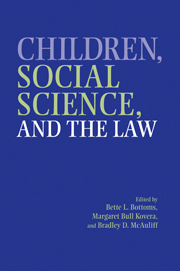Book contents
- Frontmatter
- Contents
- Acknowledgments
- Contributors
- 1 Children, Social Science, and the Law: An Introduction to the Issues
- PART I CHILDREN'S RIGHTS, THEIR CAPABILITIES, AND SOCIETY'S RESPONSIBILITIES TO CHILDREN
- 2 The Personal Responsibility and Work Opportunity Reconciliation Act of 1996: What Will It Mean for Children?
- 3 Advocacy for Children's Rights
- 4 Children's Rights and Capacities
- 5 Children's Legal Representation in Civil Litigation
- PART II CHILDREN AND FAMILY CHANGE
- PART III JUVENILE AGGRESSION AND JUVENILE JUSTICE
- PART IV CHILDREN AS VICTIMS AND WITNESSES
- PART V CONCLUSIONS AND FUTURE DIRECTIONS
- Author Index
- Case Index
- Subject Index
- References
2 - The Personal Responsibility and Work Opportunity Reconciliation Act of 1996: What Will It Mean for Children?
Published online by Cambridge University Press: 24 July 2009
- Frontmatter
- Contents
- Acknowledgments
- Contributors
- 1 Children, Social Science, and the Law: An Introduction to the Issues
- PART I CHILDREN'S RIGHTS, THEIR CAPABILITIES, AND SOCIETY'S RESPONSIBILITIES TO CHILDREN
- 2 The Personal Responsibility and Work Opportunity Reconciliation Act of 1996: What Will It Mean for Children?
- 3 Advocacy for Children's Rights
- 4 Children's Rights and Capacities
- 5 Children's Legal Representation in Civil Litigation
- PART II CHILDREN AND FAMILY CHANGE
- PART III JUVENILE AGGRESSION AND JUVENILE JUSTICE
- PART IV CHILDREN AS VICTIMS AND WITNESSES
- PART V CONCLUSIONS AND FUTURE DIRECTIONS
- Author Index
- Case Index
- Subject Index
- References
Summary
In 1991, presidential candidate Bill Clinton promised to “end welfare as we know it.” With the enthusiastic support of a Republican-controlled Congress, President Clinton signed the Personal Responsibility and Work Opportunity Reconciliation Act (PRWORA) in August 1996, thereby effectively carrying out his promise. This legislation fundamentally transformed the nature of the cash welfare program that had been created in 1935 in response to the economic hardships brought about by the Great Depression, replacing a guaranteed entitlement program with a time-limited benefit.
A policy shift of this magnitude raises many questions, but a central concern of many policy analysts and researchers has been the implications of the new welfare system for children in recipient families and in families who may have received welfare benefits under the old law but are now or soon will be excluded from participation. In this chapter we will briefly describe the nature of this policy transformation and review research that offers a glimpse at the potential consequences of these changes for children in low-income families. Additionally, we will briefly describe the work currently in progress on a number of fronts that may provide scholars and policy makers with the data necessary to discern the impact of welfare reform on the well-being of children in low-income families.
- Type
- Chapter
- Information
- Children, Social Science, and the Law , pp. 15 - 50Publisher: Cambridge University PressPrint publication year: 2002



